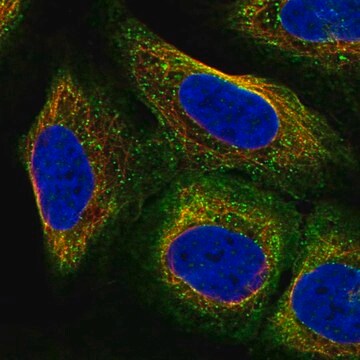MABF3203
Anti-Tissue Factor/CD142 Antibody, clone HTF-1
Synonym(s):
Coagulation factor III, HTF1-7B8, TF, Thromboplastin
About This Item
Recommended Products
biological source
mouse
Quality Level
antibody form
purified antibody
antibody product type
primary antibodies
clone
HTF-1, monoclonal
mol wt
calculated mol wt 33 kDa
observed mol wt ~42-48 kDa
purified by
using protein G
species reactivity
human, bovine
packaging
antibody small pack of 100
technique(s)
ELISA: suitable
dot blot: suitable
flow cytometry: suitable
immunohistochemistry: suitable
inhibition assay: suitable
western blot: suitable
isotype
IgG1κ
epitope sequence
Unknown
Protein ID accession no.
UniProt accession no.
storage temp.
-10 to -25°C
Gene Information
human ... F3(2152)
Specificity
Immunogen
Application
Tissue factor: Identification and characterization of cell types in human placentae. (Faulk, W.P., C.A. Labarrere, and S.D. Carson. (1990). Blood 76:86-96).
Immunofluorescent studies of tissue factor on U87MG cells: Evidence for non-uniform distribution. Carson, S.D., and S.J. Pirruccello. (1993). Blood Coagulation and Fibrinolysis 4:911-920).
Flow Cytometry
Tissue factor antigen and activity are not expressed on the surface of intact cells isolated from an acute promyelocytic leukemia patient. (Carson, S.D., S.J. Pirruccello, and W.D. Haire. (1990). Thrombos. Res. 59:159-170).
Immunohistochemistry
Participation of cell-mediated immunity in the deposition of fibrin in glomerulonephritis. (Neale, T.J., P.G. Tipping, S.D. Carson, and S.R. Holdsworth. (1988). Lancet, No. 8606, 2:421-424).
Tissue factor antigen in senile plaques of Alzheimer′s disease. (McComb, R.D., K.A. Miller, and S.D. Carson. (1991). Am. J. Path. 139:491-494).
Immunoaffinity purification of the tissue factor protein
An inhibitory monoclonal antibody against human tissue factor. (Carson, S.D., S.E. Ross, R. Bach, and A. Guha. (1987). Blood 70:490-493).
Evaluated by Western Blotting in A-431cell lysate.
Western Blotting Analysis: A 1:500 dilution of this antibody detected Tissue Factor/CD142 in A-431 cell lysate.
Tested Applications
ELISA Analysis: A representative lot detected Tissue Factor/CD142 in ELISA applications (Carson, S.D., et al. (1987). Blood. 70(2):490-3).
Western Blotting Analysis: A representative lot detected Tissue Factor/CD142 in Western Blotting applications (Carson, S.D., et al. (1987). Blood. 70(2):490-3). .
Dot Blot: A representative lot detected Tissue Factor/CD142 in Dot Blot applications (Carson, S.D., et al. (1987). Blood. 70(2):490-3).
Inhibition Assay: A representative lot detected Tissue Factor/CD142 in Inhibition applications (Carson, S.D., et al. (1987). Blood. 70(2):490-3).
Note: Actual optimal working dilutions must be determined by end user as specimens, and experimental conditions may vary with the end user.
Target description
Physical form
Reconstitution
Storage and Stability
Other Notes
Disclaimer
Not finding the right product?
Try our Product Selector Tool.
Storage Class Code
12 - Non Combustible Liquids
WGK
WGK 2
Flash Point(F)
Not applicable
Flash Point(C)
Not applicable
Certificates of Analysis (COA)
Search for Certificates of Analysis (COA) by entering the products Lot/Batch Number. Lot and Batch Numbers can be found on a product’s label following the words ‘Lot’ or ‘Batch’.
Already Own This Product?
Find documentation for the products that you have recently purchased in the Document Library.
Our team of scientists has experience in all areas of research including Life Science, Material Science, Chemical Synthesis, Chromatography, Analytical and many others.
Contact Technical Service







